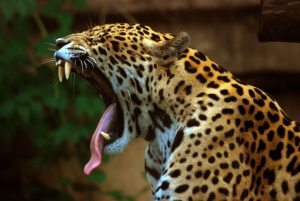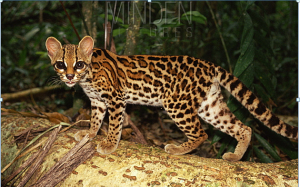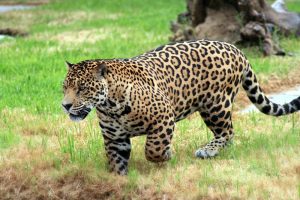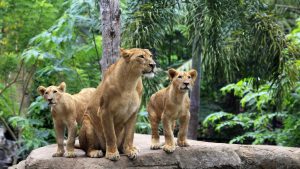…while Department of Environment and GWCMC work with animals and communities
CATTLE rearing in some communities of Guyana have always been a big undertaking, and it currently continues to maintain this pattern. However, for some areas there is an issue of wildcats, primarily in the form of jaguars, attacking cattle.

On a recent visit by the Pepperpot Magazine to the community of Ithaca, it was found that jaguars had already destroyed some cattle, leaving others evidently in a traumatised state. Many of the cattle had a ‘sick’ and hungry look, very timid, yet ready to strike out at any one who crossed their path close enough. It was not a pleasant sight, especially one cow lay sick and eventually died.
MoA and GWCMC
Having encountered such a situation, the Pepperpot Magazine, reacting to calls for help by some cattle farmers, made contact with officials of the Ministry of Agriculture (MoA), who immediately referred us to the Guyana Wildlife Conservation and Management Commission (GWCMC) and there contact was eventually made.
According to the Stakeholder Management Coordinator of the Department of Environment, Ms. Onika Stellingburg, they are fully cognisant of “instances of communities being affected by the presence of wildcats” and have thus offered recommended ways, channelled through the GWCMC, by which there can be the possible co-existence of human beings and the wildcats.

The GWCMC noted that there are six species of wildcats in Guyana, which are the jaguar, ocelot, puma, oncilla, jaguarondi and margay. It noted, “According to Section 4 (7) of the Wildlife Conservation, Management and Sustainable Use Regulations (2019), all wildcats are protected and it is an offence to collect, hold in captivity, kill, hunt, or otherwise molest a protected species,” adding that the most common wildcats that communities are affected by are the jaguar and puma.
Important considerations
The GWCMC emphasised that there are some important points to take into consideration when dealing with these wildcats. These include that these wildcats are apex predators, which are relatively small in number; yet they help to maintain a balance in the population of the species on which they they prey; therefore, removing these predators can have catastrophic consequences on the environment.
The expansion of human settlements into abandoned or overgrown land, which forms the natural habitat for these animals; older animals looking for and having access to easy prey through animal husbandry that may not be carefully planned out; and unsanitary environments are some factors that can cause wildcats to linger in a community.
The GWCMC stated such situations may lead to disastrous results for all parties involved, where people lose their crops, livestock, property, and sometimes their lives. At the same time, while the animals are often killed in retaliation or to ‘prevent’ future conflicts, it should be noted that it is unlikely for a wildcat to attack any human being unless it feels threatened.
Recommendations

Because these cats are wild and territorial, the GWCMC has advised against entrapping or relocating them, unless with the authorisation of the commission. The commission said that by “removing one from an area would open room for another to inhabit the same area. To decide on the best course of action for a particular area, the commission would have to do an assessment and then in consultation with the community, decide on the best way forward” it advocated.
The commission further recommended that in order to minimise conflicts with’ big cats,’ consideration should be given to housing dogs in kennels; being extra vigilant with livestock – tracking pregnancy of animals and plan for the birth of their young; keeping animals in corrals (cages) as much as possible; paying close attention to young calves from the time they are born, through to when they are around two years old.
It indicated that young calves are the most vulnerable and should be kept indoors as much as possible. At the same time, even children should be taught to be watchful and to be prepared for any eventuality.
GWCMC committed
The GWCMC counselled that when in direct confrontation with any of the ‘big cats,’ a person should not turn his or her back or run. Instead, it recommends that the jaguar or any other ‘big cat’ should be looked at straight in the face, while making as much noise as can be made.
Further, it advised that the surroundings should be kept clean at all times, and flashing lights should be installed on pens or corrals. At the same time, GWCMC said that there should be reduced hunting, especially for animal species that are the prey for ‘big cats.’ Jointly, the commission is also asking that people do not kill wild animals unless human life is in direct danger.

6. The oncilla, Lepardus tigrinus, is also known as the Little Spotted Cat, Tigrillo, Tiger Cat or Little Tiger Cat. It is covered with beautiful fur that can be tan or ochre in colour, but it has been reported that one fifth of all oncillas are completely black; they are most active at twilight and nights
The commission stated, “Over the past year, we have conducted outreaches in 21 communities across the country. These include Surama, Matthews Ridge, Whitewater, Mainstay/Whyaka, Tapakuma, Parika, and Hogg Island, in a bid to find joint solutions that will reduce conflict between humans and wild cat, so we can co-exist mutually.” This, it says, demonstrates it’s committed to the purpose of ensuring the conservation, management and sustainable use of Guyana’s wildlife.
In the case of Ithaca, Mr. Deuel Hughes, Communications Officer of the Guyana Wildlife Conservation and Management Commission, told the Pepperpot Magazine that the commission is making urgent efforts to pay a special visit to the affected community to meet with cattle farmers, find out their specific situation and offer all the assistance they are able to give. (mercilinburke3017@gmail.com)



.jpg)








